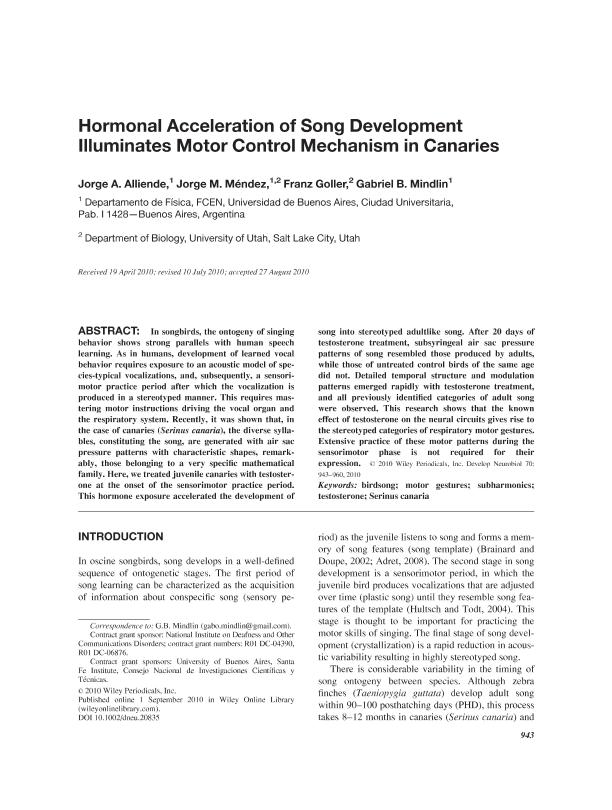Artículo
Hormonal acceleration of song development illuminates motor control mechanism in canaries
Fecha de publicación:
12/2010
Editorial:
John Wiley & Sons Inc
Revista:
Developmental Neurobiology
ISSN:
1932-8451
Idioma:
Inglés
Tipo de recurso:
Artículo publicado
Clasificación temática:
Resumen
In songbirds, the ontogeny of singing behavior shows strong parallels with human speech learning. As in humans, development of learned vocal behavior requires exposure to an acoustic model of species-typical vocalizations, and, subsequently, a sensorimotor practice period after which the vocalization is produced in a stereotyped manner. This requires mastering motor instructions driving the vocal organ and the respiratory system. Recently, it was shown that, in the case of canaries (Serinus canaria), the diverse syllables, constituting the song, are generated with air sac pressure patterns with characteristic shapes, remarkably, those belonging to a very specific mathematical family. Here, we treated juvenile canaries with testosterone at the onset of the sensorimotor practice period. This hormone exposure accelerated the development of song into stereotyped adultlike song. After 20 days of testosterone treatment, subsyringeal air sac pressure patterns of song resembled those produced by adults, while those of untreated control birds of the same age did not. Detailed temporal structure and modulation patterns emerged rapidly with testosterone treatment, and all previously identified categories of adult song were observed. This research shows that the known effect of testosterone on the neural circuits gives rise to the stereotyped categories of respiratory motor gestures. Extensive practice of these motor patterns during the sensorimotor phase is not required for their expression. © 2010 Wiley Periodicals, Inc.
Palabras clave:
Birdsong
,
Motor Gestures
,
Serinus Canaria
,
Subharmonics
,
Testosterone
Archivos asociados
Licencia
Identificadores
Colecciones
Articulos(IFIBA)
Articulos de INST.DE FISICA DE BUENOS AIRES
Articulos de INST.DE FISICA DE BUENOS AIRES
Citación
Alliende Gonzalez, Jorge Andrés; Mendez, Jorge Manuel; Goller, Franz; Mindlin, Bernardo Gabriel; Hormonal acceleration of song development illuminates motor control mechanism in canaries; John Wiley & Sons Inc; Developmental Neurobiology; 70; 14; 12-2010; 943-960
Compartir
Altmétricas




